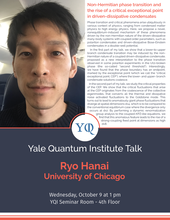Non-Hermitian phase transition and the rise of a critical exceptional point in driven-dissipative condensates
Phase transition and critical phenomena arise ubiquitously in various context of physics, ranging from condensed matter physics to high energy physics. Here, we propose a novel, nonequilibrium-induced mechanism of these phenomena driven by the non-Hermitian nature of the driven-dissipative many-body systems with coupled order parameters, such as polariton condensates and driven-dissipative Bose-Einstein condensates in a double-well potential.
In the first part of my talk, we show that a lower-to-upper branch condensate transition may be induced by the non-Hermitian nature of a coupled driven-dissipative condensate, proposed as a new interpretation to the phase transition observed in some polariton experiments in the U(1)-broken phase (the so-called “second threshold”). Interestingly, we have found that the phase boundary has an endpoint, marked by the exceptional point (which we call the “critical exceptional point, CEP”), where the lower- and upper- branch condensate solutions coalesce.
In the second part of my talk, we study the critical properties of the CEP. We show that the critical fluctuations that arise at the CEP originates from the coalescence of the collective eigenmodes, that converts all the thermal and dissipative noise activated fluctuations to the Goldstone mode. This turns out to lead to anomalously giant phase fluctuations that diverge at spatial dimensions d≤4, which is to be compared to the conventional equilibrium case where the divergence only occurs at d≤2. By performing a dynamic renormalization group analysis to the coupled-KPZ-like equations, we find that this anomalous feature leads to the rise of a strong-coupling fixed point at dimensions as high as d<8.
